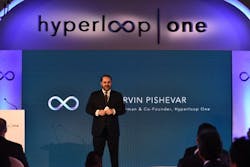Hyperloop One and Indian Government Officials Lead First-Ever Summit to Discuss India's Most Promising Hyperloop Routes
Hyperloop One convened a landmark innovation summit — The Hyperloop One Vision For India in New Delhi. The summit, which was graced by Shri Suresh Prabhu, Hon'ble Minister of Railways and Shri Amitabh Kant, CEO, NITI Aayog, discussed how Hyperloop One can integrate with and augment India's vast transport network with reliable, clean, and on-demand autonomous transport, connecting India's major cities at faster-than-airline speeds. Hyperloop can reinvent and transform transportation in India, making the nation a global leader in innovation, efficiency, and regional economic growth.
The Hyperloop concept has generated excitement and interest from start-ups around the world since it was first proposed in 2013. While other start-ups have not yet moved beyond basic research, Hyperloop One is the only company that is building a functional Hyperloop system. Following the successful public demonstration of the propulsion motor in May 2016 Hyperloop One is on track to run the world's first full-system test in 2017 in Nevada.
Suresh Prabhu, Minister of Railways, Government of India, while speaking at the summit said, "We are living in exciting times, with new ideas and innovation coming in from all over the world. Indian Railways is one of the largest rail networks globally, and we are committed towards modernizing and revamping the system. We are keenly watching new developments which can be implemented here, and want to build technologies in India, rather than importing them. I would like to congratulate Hyperloop One on this initiative, as it is very interesting to see that they can make long distance travel possible in very little time. We will be keenly monitoring their progress going forward."
Amitabh Kant, CEO, Niti Aayog while addressing the gathering said, "These are transformative days in India, we are currently growing at a rate of 6-7% per annum, and aim to grow even faster in the coming years. This growth will be fuelled by rapid urbanization, but we need to ensure sustainable growth which is also transformational. India needs technology to disrupt transportation which can provide solutions to move a large number of people in these urban centres. We are willing to facilitate such a catalyst and are happy to work in partnership with Hyperloop One to leapfrog the country. The future for Hyperloop One belongs in India."
"Prime Minister Narendra Modi's vision for transforming India and the role he sees of technology in driving this change is indeed remarkable," said Shervin Pishevar, executive chairman of Hyperloop One. "India is an extremely important geography for developing Hyperloop networks and reimagining how cities and regions work. The Prime Minister's vision of connecting the country is directly aligned with Hyperloop One's objective of connecting the world. With initiatives such as 'Make In India' and 'Digital India', we do see ourselves working in this direction in India."
"Hyperloop One will help accelerate India's growth towards building substantial infrastructure that is both financially and environmentally sustainable," said Rob Lloyd, CEO of Hyperloop One. "A transportation system like the Hyperloop will undoubtedly ease the pressure on existing infrastructure while enhancing the quality of life of the people. We are already working with the governments around the world on passenger and freight projects, and we look forward to also partnering with India to support this endeavour."
The Hyperloop One Vision For India summit also showcased five Hyperloop One Global Challenge (HOGC) semi-finalist teams from India, each of which proposed high-speed transportation routes that could improve the lives of millions of Indian citizens. The HOGC required the teams to develop regional proposals integrating Hyperloop One's disruptive transport technology to move passengers and freight from point-to-point, swiftly, and on-demand.
The HOGC which was kicked off in May 2016 invited teams across the world to put forward a comprehensive and commercially viable transport plan covering economical and policy aspects of their respective cities, regions and countries. The HOGC received more than 2,600 registrants from 90 countries, and narrowed the field down to 35 semi-finalists across all continents with a potential pipeline worth $26 billion. India led the way with the highest number of registrants and had the most vocal supporters of Hyperloop One on social media. The India semi-finalists include:
Aecom - Bengaluru-to-Chennai: 334 km in 20 minutes. Meeting the demand of a passenger and freight super-corridor growing at 15% a year. LUX Hyperloop Network - Bengaluru-to-Thiruvananthapuram: 736 km in 41 minutes. Connects two major ports in southern India with population centres of Coimbatore and Kochi. Dinclix GroundWorks - Delhi-to-Mumbai via Jaipur and Indore: 1,317 km in 55 minutes. Freight and passengers. Connects two megacities and creates seaport access for landlocked intermediary cities in the interior. Hyperloop India - Mumbai-to-Chennai via Bengaluru: 1,102 km. 50 minutes. Phased development for freight and passengers. Boosts capacity at ports of Mumbai and Chennai, creates a Suez Canal-like link between India's coasts. Infi-Alpha - Bengaluru to Chennai: 334 km in 20 minutes. Meeting the demand of a passenger and freight super-corridor growing at 15% a year. Connects with major airports.